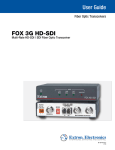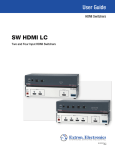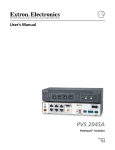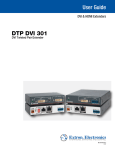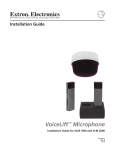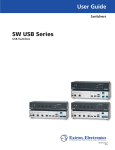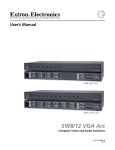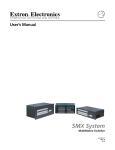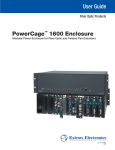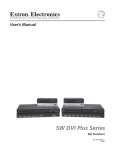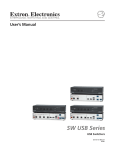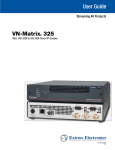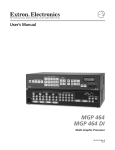Download Extron electronics VoiceLift Operating instructions
Transcript
VoiceLift™ Microphone VLM 1000 and VLM 2000 68-1628-01 Rev. A 02 09 Precautions Safety Instructions • English Warning This symbol is intended to alert the user of important operating and maintenance (servicing) instructions in the literature provided with the equipment. Power sources • This equipment should be operated only from the power source indicated on the product. This equipment is intended to be used with a main power system with a grounded (neutral) conductor. The third (grounding) pin is a safety feature, do not attempt to bypass or disable it. This symbol is intended to alert the user of the presence of uninsulated dangerous voltage within the product’s enclosure that may present a risk of electric shock. Power disconnection • To remove power from the equipment safely, remove all power cords from the rear of the equipment, or the desktop power module (if detachable), or from the power source receptacle (wall plug). Caution Read Instructions • Read and understand all safety and operating instructions before using the equipment. Retain Instructions • The safety instructions should be kept for future reference. Follow Warnings • Follow all warnings and instructions marked on the equipment or in the user information. Avoid Attachments • Do not use tools or attachments that are not recommended by the equipment manufacturer because they may be hazardous. Consignes de Sécurité • Français Power cord protection • Power cords should be routed so that they are not likely to be stepped on or pinched by items placed upon or against them. Servicing • Refer all servicing to qualified service personnel. There are no user-serviceable parts inside. To prevent the risk of shock, do not attempt to service this equipment yourself because opening or removing covers may expose you to dangerous voltage or other hazards. Slots and openings • If the equipment has slots or holes in the enclosure, these are provided to prevent overheating of sensitive components inside. These openings must never be blocked by other objects. Lithium battery • There is a danger of explosion if battery is incorrectly replaced. Replace it only with the same or equivalent type recommended by the manufacturer. Dispose of used batteries according to the manufacturer’s instructions. Avertissement Ce symbole sert à avertir l’utilisateur que la documentation fournie avec le matériel contient des instructions importantes concernant l’exploitation et la maintenance (réparation). Alimentations• Ne faire fonctionner ce matériel qu’avec la source d’alimentation indiquée sur l’appareil. Ce matériel doit être utilisé avec une alimentation principale comportant un fil de terre (neutre). Le troisième contact (de mise à la terre) constitue un dispositif de sécurité : n’essayez pas de la contourner ni de la désactiver. Ce symbole sert à avertir l’utilisateur de la présence dans le boîtier de l’appareil de tensions dangereuses non isolées posant des risques d’électrocution. Déconnexion de l’alimentation• Pour mettre le matériel hors tension sans danger, déconnectez tous les cordons d’alimentation de l’arrière de l’appareil ou du module d’alimentation de bureau (s’il est amovible) ou encore de la prise secteur. Attention Lire les instructions• Prendre connaissance de toutes les consignes de sécurité et d’exploitation avant d’utiliser le matériel. Conserver les instructions• Ranger les consignes de sécurité afin de pouvoir les consulter à l’avenir. Respecter les avertissements • Observer tous les avertissements et consignes marqués sur le matériel ou présentés dans la documentation utilisateur. Eviter les pièces de fixation • Ne pas utiliser de pièces de fixation ni d’outils non recommandés par le fabricant du matériel car cela risquerait de poser certains dangers. Protection du cordon d’alimentation • Acheminer les cordons d’alimentation de manière à ce que personne ne risque de marcher dessus et à ce qu’ils ne soient pas écrasés ou pincés par des objets. Réparation-maintenance • Faire exécuter toutes les interventions de réparation-maintenance par un technicien qualifié. Aucun des éléments internes ne peut être réparé par l’utilisateur. Afin d’éviter tout danger d’électrocution, l’utilisateur ne doit pas essayer de procéder lui-même à ces opérations car l’ouverture ou le retrait des couvercles risquent de l’exposer à de hautes tensions et autres dangers. Fentes et orifices • Si le boîtier de l’appareil comporte des fentes ou des orifices, ceux-ci servent à empêcher les composants internes sensibles de surchauffer. Ces ouvertures ne doivent jamais être bloquées par des objets. Lithium Batterie • Il a danger d’explosion s’ll y a remplacment incorrect de la batterie. Remplacer uniquement avec une batterie du meme type ou d’un ype equivalent recommande par le constructeur. Mettre au reut les batteries usagees conformement aux instructions du fabricant. Sicherheitsanleitungen • Deutsch Vorsicht Dieses Symbol soll dem Benutzer in der im Lieferumfang enthaltenen Dokumentation besonders wichtige Hinweise zur Bedienung und Wartung (Instandhaltung) geben. Stromquellen • Dieses Gerät sollte nur über die auf dem Produkt angegebene Stromquelle betrieben werden. Dieses Gerät wurde für eine Verwendung mit einer Hauptstromleitung mit einem geerdeten (neutralen) Leiter konzipiert. Der dritte Kontakt ist für einen Erdanschluß, und stellt eine Sicherheitsfunktion dar. Diese sollte nicht umgangen oder außer Betrieb gesetzt werden. Dieses Symbol soll den Benutzer darauf aufmerksam machen, daß im Inneren des Gehäuses dieses Produktes gefährliche Spannungen, die nicht isoliert sind und die einen elektrischen Schock verursachen können, herrschen. Stromunterbrechung • Um das Gerät auf sichere Weise vom Netz zu trennen, sollten Sie alle Netzkabel aus der Rückseite des Gerätes, aus der externen Stomversorgung (falls dies möglich ist) oder aus der Wandsteckdose ziehen. Achtung Lesen der Anleitungen • Bevor Sie das Gerät zum ersten Mal verwenden, sollten Sie alle Sicherheits-und Bedienungsanleitungen genau durchlesen und verstehen. Aufbewahren der Anleitungen • Die Hinweise zur elektrischen Sicherheit des Produktes sollten Sie aufbewahren, damit Sie im Bedarfsfall darauf zurückgreifen können. Befolgen der Warnhinweise • Befolgen Sie alle Warnhinweise und Anleitungen auf dem Gerät oder in der Benutzerdokumentation. Keine Zusatzgeräte • Verwenden Sie keine Werkzeuge oder Zusatzgeräte, die nicht ausdrücklich vom Hersteller empfohlen wurden, da diese eine Gefahrenquelle darstellen können. Instrucciones de seguridad • Español Schutz des Netzkabels • Netzkabel sollten stets so verlegt werden, daß sie nicht im Weg liegen und niemand darauf treten kann oder Objekte darauf- oder unmittelbar dagegengestellt werden können. Wartung • Alle Wartungsmaßnahmen sollten nur von qualifiziertem Servicepersonal durchgeführt werden. Die internen Komponenten des Gerätes sind wartungsfrei. Zur Vermeidung eines elektrischen Schocks versuchen Sie in keinem Fall, dieses Gerät selbst öffnen, da beim Entfernen der Abdeckungen die Gefahr eines elektrischen Schlags und/oder andere Gefahren bestehen. Schlitze und Öffnungen • Wenn das Gerät Schlitze oder Löcher im Gehäuse aufweist, dienen diese zur Vermeidung einer Überhitzung der empfindlichen Teile im Inneren. Diese Öffnungen dürfen niemals von anderen Objekten blockiert werden. Litium-Batterie • Explosionsgefahr, falls die Batterie nicht richtig ersetzt wird. Ersetzen Sie verbrauchte Batterien nur durch den gleichen oder einen vergleichbaren Batterietyp, der auch vom Hersteller empfohlen wird. Entsorgen Sie verbrauchte Batterien bitte gemäß den Herstelleranweisungen. Advertencia Este símbolo se utiliza para advertir al usuario sobre instrucciones importantes de operación y mantenimiento (o cambio de partes) que se desean destacar en el contenido de la documentación suministrada con los equipos. Alimentación eléctrica • Este equipo debe conectarse únicamente a la fuente/tipo de alimentación eléctrica indicada en el mismo. La alimentación eléctrica de este equipo debe provenir de un sistema de distribución general con conductor neutro a tierra. La tercera pata (puesta a tierra) es una medida de seguridad, no puentearia ni eliminaria. Este símbolo se utiliza para advertir al usuario sobre la presencia de elementos con voltaje peligroso sin protección aislante, que puedan encontrarse dentro de la caja o alojamiento del producto, y que puedan representar riesgo de electrocución. Desconexión de alimentación eléctrica • Para desconectar con seguridad la acometida de alimentación eléctrica al equipo, desenchufar todos los cables de alimentación en el panel trasero del equipo, o desenchufar el módulo de alimentación (si fuera independiente), o desenchufar el cable del receptáculo de la pared. Precaucion Leer las instrucciones • Leer y analizar todas las instrucciones de operación y seguridad, antes de usar el equipo. Conservar las instrucciones • Conservar las instrucciones de seguridad para futura consulta. Obedecer las advertencias • Todas las advertencias e instrucciones marcadas en el equipo o en la documentación del usuario, deben ser obedecidas. Evitar el uso de accesorios • No usar herramientas o accesorios que no sean especificamente recomendados por el fabricante, ya que podrian implicar riesgos. 安全须知 • 中文 这个符号提示用户该设备用户手册中有重要的操作和维护说明。 这个符号警告用户该设备机壳内有暴露的危险电压,有触电危险。 注意 阅读说明书 • 用户使用该设备前必须阅读并理解所有安全和使用说明。 保存说明书 • 用户应保存安全说明书以备将来使用。 遵守警告 • 用户应遵守产品和用户指南上的所有安全和操作说明。 避免追加 • 不要使用该产品厂商没有推荐的工具或追加设备,以避免危险。 Protección del cables de alimentación • Los cables de alimentación eléctrica se deben instalar en lugares donde no sean pisados ni apretados por objetos que se puedan apoyar sobre ellos. Reparaciones/mantenimiento • Solicitar siempre los servicios técnicos de personal calificado. En el interior no hay partes a las que el usuario deba acceder. Para evitar riesgo de electrocución, no intentar personalmente la reparación/mantenimiento de este equipo, ya que al abrir o extraer las tapas puede quedar expuesto a voltajes peligrosos u otros riesgos. Ranuras y aberturas • Si el equipo posee ranuras o orificios en su caja/alojamiento, es para evitar el sobrecalientamiento de componentes internos sensibles. Estas aberturas nunca se deben obstruir con otros objetos. Batería de litio • Existe riesgo de explosión si esta batería se coloca en la posición incorrecta. Cambiar esta batería únicamente con el mismo tipo (o su equivalente) recomendado por el fabricante. Desachar las baterías usadas siguiendo las instrucciones del fabricante. 警告 电源 • 该设备只能使用产品上标明的电源。 设备必须使用有地线的供电系统供电。 第三条线 (地线)是安全设施,不能不用或跳过 。 拔掉电源 • 为安全地从设备拔掉电源,请拔掉所有设备后或桌面电源的电源线,或任何接到市 电系统的电源线。 电源线保护 • 妥善布线, 避免被踩踏,或重物挤压。 维护 • 所有维修必须由认证的维修人员进行。 设备内部没有用户可以更换的零件。为避免出现 触电危险不要自己试图打开设备盖子维修该设备。 通风孔 • 有些设备机壳上有通风槽或孔,它们是用来防止机内敏感元件过热。 不要用任何东 西挡住通风孔。 锂电池 • 不正确的更换电池会有爆炸的危险。必须使用与厂家推荐的相同或相近型号的电池。 按照生产厂的建议处理废弃电池。 FCC Class B Notice This equipment has been tested and found to comply with the limits for a Class B digital device, pursuant to part 15 of the FCC Rules. These limits are designed to provide reasonable protection against harmful interference in a residential installation. This equipment generates, uses and can radiate radio frequency energy and, if not installed and used in accordance with the instructions, may cause harmful interference to radio communications. However, there is no guarantee that the interference will not occur in a particular installation. If this equipment does cause harmful interference to radio or television reception, which can be determined by turning the equipment off and on, the user is encouraged to try to correct the interference by one or more of the following measures: • Reorient or relocate the receiving antenna. • Increase the separation between the equipment and receiver. • Connect the equipment into an outlet on a circuit different from that to which the receiver is connected. • Consult the dealer or an experienced radio/TV technician for help. Table of Contents Chapter One • Introduction . ..................................................................................................... 1-1 About this Manual..................................................................................................................... 1-2 About the VoiceLift Microphone....................................................................................... 1-2 Components. .............................................................................................................................. 1-2 Features....................................................................................................................................... 1-3 Application Diagram. ............................................................................................................... 1-4 Chapter Two • Operation and Features. ........................................................................... 2-1 Functional Overview of the VoiceLift Microphone................................................ 2-2 Audio signal transmission......................................................................................................... 2-2 Cable lengths.............................................................................................................................. 2-3 Charging Station......................................................................................................................... 2-3 Features and operation. ........................................................................................................... 2-4 Front and side panels .......................................................................................................... 2-4 Back and end panels............................................................................................................ 2-6 Charging the microphone........................................................................................................ 2-7 Using the VLC 102 charging station.................................................................................... 2-7 Using the wall charger......................................................................................................... 2-8 Setting up the VLP 102 Pendant Microphone....................................................................... 2-9 Tips for using the microphone............................................................................................... 2-11 Receiver. ......................................................................................................................................... 2-12 Receiver dome and base plate............................................................................................... 2-12 Receiver housing and back plate........................................................................................... 2-15 Removing and replacing the receiver dome........................................................................ 2-16 Secondary Receiver. ................................................................................................................ 2-18 Adapter........................................................................................................................................... 2-20 Chapter Three • SIS Configuration and Control........................................................ 3-1 Host-to-Receiver Communications................................................................................... 3-2 Receiver-initiated messages..................................................................................................... 3-2 Error response............................................................................................................................ 3-2 Commands and Responses. .................................................................................................. 3-3 Using the command/response table. ...................................................................................... 3-3 Symbol definitions..................................................................................................................... 3-3 Command/response Table for SIS Commands........................................................... 3-4 Chapter Four • Special Application...................................................................................... 4-1 Setting Up an Instant Alert. ................................................................................................. 4-2 Applications Diagram.............................................................................................................. 4-5 VoiceLift™ Microphone • Table of Contents i PRELIMINARY Pendant Microphone. ............................................................................................................... 2-4 Table of Contents, cont’d Chapter Five • Installing and Mounting the Receiver.......................................... 5-1 Planning the Installation ..................................................................................................... 5-2 Placement of the receiver . ..................................................................................................... 5-2 Room layout and content considerations ............................................................................ 5-2 Installation Overview............................................................................................................... 5-4 Stage 1: Installing the receiver base and housing................................................................ 5-4 Installing in a drop ceiling................................................................................................... 5-4 Installing in a junction box.................................................................................................. 5-5 Installing on a wall or other hard surface.......................................................................... 5-5 Stage 2: Connecting the receiver and adapter. .................................................................... 5-5 Stage 3: Setting up the microphone and testing the system.............................................. 5-5 Appendix A • Reference Material......................................................................................... A-1 Specifications — VLR 102 and VLR 102 SR.................................................................. A-2 PRELIMINARY Specifications — VLP 102 Pendant Microphone. .................................................... A-4 Specifications — VLC 102 Charging Station.............................................................. A-5 Part Numbers and Accessories.......................................................................................... A-6 Included parts............................................................................................................................ A-6 VLM 1000 VoiceLift Microphone kit, part #42-139-01...................................................... A-6 VLM 2000 VoiceLift Microphone kit, part #42-139-02...................................................... A-6 Optional accessories................................................................................................................. A-7 Appendix B • Firmware Updates............................................................................................B-1 Downloading a Firmware File. ...........................................................................................B-2 Updating Firmware Using the Firmware Loader.....................................................B-2 All trademarks mentioned in this manual are the properties of their respective owners. 68-1628-01 A 02 09 ii VoiceLift™ Microphone • Table of Contents 1 Chapter One Introduction About this Manual About the VoiceLift Microphone Application Diagram PRELIMINARY VoiceLift™ Microphone Introduction About this Manual This manual discusses the components and operation of the Extron VoiceLift™ Microphone. For details on installation procedures, refer to the VoiceLift Microphone Installation Guide, part #68-1629-01. The following terminology is used in this manual: •VoiceLift Microphone refers to the entire system, which includes the pendant microphone, the receiver, the charging station, and any secondary receiver(s). •Pendant microphone refers to the VLP 102 microphone unit only. •Receiver refers to the VLR 102 infrared (IR) receiver, which mounts onto a wall or ceiling. •Secondary receiver refers to the optional additional receiver (VLR 102 SR), which can be installed to expand coverage in a large or odd-shaped room. •Charging station refers to the VLC 102 charger unit for the pendant microphone. About the VoiceLift Microphone PRELIMINARY The VoiceLift Microphone is a low-power classroom amplification system that ensures that a teacher can be clearly heard at a comfortable level throughout the entire room (also referred to as a soundfield system). The pendant microphone, worn by the teacher/speaker, picks up speech and transmits it via IR signal to the receiver. From the receiver, the signal is fed to an Extron PoleVault® switcher/ amplifier, which powers strategically placed speakers to improve the signal-tonoise ratio of the teacher’s voice to at least +15 dB. Components The VoiceLift Microphone consists of the following components: •Pendant microphone (VLP 102) — The pendant microphone is worn by the teacher, either on a lanyard around the neck or clipped to clothing. It features volume control, a power on/off switch, an auxiliary input to support an optional boom or lapel microphone, and an auxiliary line input connector to feed in a source such as an MP3 player. Pendant microphones can also be hand-held for use by students, if desired. • Receiver (VLR 102) — The receiver is the main sensor for the VoiceLift Microphone. It features captive screw connectors for auxiliary input, RS-232, contact input, and relay output; RJ 45 connectors for power, communication with the PoleVault switcher/amplifier, and audio output; and two DIP switches that control the volume change tone and the output pin mode. •Secondary receiver (VLR 102 SR) — The optional secondary receiver extends the signal to cover large or odd-shaped rooms. It contains RJ-45 connectors for cables to the main IR receiver and to the PoleVault switcher/amplifier. Up to four secondary receivers can be used with a VoiceLift Microphone. •Charging station — The optional microphone charging station contains slots in which one or two pendant microphones can be placed for their batteries to be recharged. The charging station is powered by an external power supply. C 1-2 Do not charge alkaline or NiCd batteries. VoiceLift™ Microphone • Introduction Features The VoiceLift Microphone features the following: Lightweight pendant microphone — The VLP 102 pendant microphone is made of lightweight and impact-resistant polycarbonate material, and can be worn comfortably around the neck or clipped to clothing. Feedback suppression — Advanced, integrated DSP enables automatic feedback suppression while enhancing high frequency consonant sounds to maximize sound quality and intelligibility. Two microphones per classroom — The VoiceLift microphone supports up to two pendant microphones in each classroom. The microphones can be used by teachers and students, as desired. Volume and Power/Mute buttons — The pendant microphone contains easily accessible buttons on the sides to raise and lower the volume, mute the sound, and power the microphone on and off. Auxiliary line input — An auxiliary input connector on the microphone enables input from an MP3 player or other source. Battery power — The VLP 102 pendant microphone is powered by a single NiMh or alkaline AA battery. NiMh batteries can be recharged via the VLC 102 charging station or a wall charger. Charging station — The VLP 102 desktop charging station holds and recharges up to two VoiceLift microphones simultaneously. Mounting options — The VLR 102 receiver is compact and can be mounted on a wall or ceiling, or to a junction box. Expandable coverage — The optional VLR 102 SR secondary receiver provides expanded coverage for large or odd-sized rooms. VoiceLift™ Microphone • Introduction 1-3 PRELIMINARY Instant Alert e-mail messaging — The VoiceLift receiver can be wired to enable the teacher to send e-mail alerts by pressing the microphone Volume button when assistance is required. Introduction, cont’d Application Diagram The following diagram shows a possible installation of a VoiceLift microphone system. SI 3C LP Plenum Full-Range Ceiling Speakers Free GlobalViewer Software VoiceLift VLR 102 Receiver POWER 12V 3A I N P U T S TCP/IP Network 1A RGB 2A VIDEO 3 MAX RGB 1B 2B 4 VIDEO O U T P U T S ® LISTED US AUDIO/VIDEO 17TT APPARATUS HIGH ON PASS STEREO FILTER ON AMPLIFIED OUTPUTS AUX/MIX OFF DUAL MONO IN RS-232 Tx Rx MLC/IRL IR 12V A B C 4/8 Ohms R DC VOL 10V VOL/MUTE PVS 204SA PRELIMINARY PoleVault® Switcher / Amplifier VoiceLift VLP 102 Pendant Microphone 1 O VIDE Y LA 2 SP DI X O AU VIDE F OF 3 ON PC ME LU VO G NFI CO E AG IM E MUT 4 4 IP MLC Plus 10 MLC 104 IP Plus MediaLink Controller Connection diagram for VoiceLift Microphone 1-4 VoiceLift™ Microphone • Introduction 2 Chapter Two Operation and Features Functional Overview of the VoiceLift Microphone Charging Station Pendant Microphone Receiver Secondary Receiver Adapter PRELIMINARY VoiceLift™ Microphone Operation and Features Functional Overview of the VoiceLift Microphone The VoiceLift Microphone is a soundfield system, which is a low-power classroom amplification system that ensures that the teacher can be clearly heard at a comfortable level throughout the classroom. The pendant microphone, worn by the teacher/speaker, picks up speech and transmits it via IR signal to the receiver. From the receiver, the signal is fed to a PoleVault switcher/amplifier, which powers strategically placed speakers to improve the signal-to-noise ratio of the teacher’s voice to at least +15 dB. Audio signal transmission The VoiceLift Microphone components process an audio signal as follows: 1 PRELIMINARY VLP 102 Pendant Microphone Out OUT In OUT IN IN 2 CTS-2 O 1 N RS-232 Tx Rx TONE MIX AUX IN + CTC IN RLY NO C 2 VLR 102 SR Secondary Receiver MLC Controller Connection VLR 102 Receiver (optional) 3 VoiceLift Adapter RGB 1A 2A VIDEO 3 RGB POWER 12V 3A MAX I N P U T S O U T P U T S 1B 2B 4 AMPLIFIED OUTPUTS LISTED 17TT US AUDIO/VIDEO ® VIDEO 4/8 Ohms APPARATUS ON HIGH PASS FILTER STEREO ON OFF AUX/MIX IN DUAL MONO L RS-232 MLC/IR Tx Rx IR 12V A B C R DC VOL 10V VOL/MUTE PoleVault Switcher 4 VoiceLift Microphone connections and signal path a 2-2 Pendant microphone — The VLP 102 pendant microphone picks up speech from the instructor and transmits a mono audio signal via IR on the selected channel (2.3 MHz or 2.8 MHz). VoiceLift™ Microphone • Operation and Features b Receivers — The VLR 102 receiver and the optional VLR 102 secondary receiver(s) pick up the IR signal from the microphone. If secondary receivers are present, the VLR 102 processes the signal from them. The receivers output a balanced -10 dBV line level signal via an RJ-45 connector. The signal is passed to the PoleVault switcher/amplifier through an unshielded twisted pair (UTP) cable. c Adapter — The RJ-45 to captive screw VoiceLift Adapter passes the audio signal from the VLR 102 receiver to the PoleVault switcher. d PoleVault switcher — The PoleVault switcher also functions as an amplifier for the VoiceLift Microphone. It receives the audio signal from the VLR 102 receiver, amplifies it, and sends it to strategically placed loudspeakers to improve the signal-to-noise ratio of the teacher’s voice to at least +15 dB. Cable lengths Cable connecting: Minimum Maximum Receiver to PoleVault switcher 5' (1.5 m) 100' (30.4 m) Receiver to Secondary Receiver, or Secondary Receiver to Secondary Receiver 5' (1.5 m) 100' (30.4 m) Total cable length — 300' (91.4 m) Charging Station The VLC 102 charging station recharges the VLP 102 pendant microphone’s battery. It contains two slots, enabling two microphones to be charged simultaneously. The charging station is powered by an external wall power supply (provided). Wall charger 2 1 VLC 102 charging station The VLC 102 charging station has the following connections: a Microphone slots — Insert one or two VLP 102 microphones into these slots to charge their batteries. Each slot contains two charging contacts that mate with the two charging contacts on the bottom panel of the microphone. When two microphones are in the charging station, each is charged independently of the other, and the two can finish charging at different times. VoiceLift™ Microphone • Operation and Features 2-3 PRELIMINARY The following table shows the recommended minimum and maximum lengths of cable between system components. Operation and Features, cont’d b DC power jack — Plug a 5 V, 0.5 A to 1 A wall charger into this coaxial center positive DC jack to provide power to the charging station. For charging status, check the microphone’s Pwr LED (see d, “Pwr LED”, under “Back and end panels” on page 2-6). Pendant Microphone The VoiceLift VLP 102 is a lightweight pendant microphone that can be worn around the neck on a lanyard (provided) or clipped to clothing. It operates via IR at two frequencies: 2.3 MHz, on channels A and C, and 2.8 MHz, on channels B and D. The microphone picks up speech and transmits a signal wirelessly to the VLR 102 receiver. The microphone is powered by one AA battery, which can be recharged using the VLC 102 charging station or a wall charger. Features and operation The VLP 102 pendant microphone has the following controls and connections: PRELIMINARY Front and side panels 4 1 2 5 6 3 7 VLP 102 pendant microphone front and side panels a Auxiliary microphone input port (Mic) — This 2.5 mm TS jack provides +3.3 V plug-in power for an additional lapel or headset microphone. When an external microphone is connected, the internal microphone element is switched off. The Mic port accepts the following connector configuration: Tip (+) TS Signal Tip Audio signal + bias voltage Sleeve Ground Sleeve ( ) 2.5 mm TS connector for auxiliary microphone 2.5 mm TS Connector 2-4 VoiceLift™ Microphone • Operation and Features b Audio input port (Audio In) — Connect an MP3 player or other audio device to this 3.5 mm TRS jack for auxiliary audio line input. When a device is plugged into this port, its audio is mixed with either the internal microphone or any external microphone connected to the Mic jack (a). N Because the audio input is mixed with the microphone, pressing the Volume button on the microphone affects the volume of the audio input device. However, it is recommended that you use the volume control of the input device instead of the microphone’s Volume button to control the levels of this audio input. Tip (+) Ring (-) Sleeve ( ) TRS Signal Tip Left channel Ring Right channel Sleeve Ground 3.5 mm Stereo Plug Connector (balanced) c Volume button — Press the top part of this rocker button to raise the microphone volume, and the bottom part to lower the volume. When this button is pressed, the receiver produces a tone that signals that the volume is being adjusted, and the Pwr LED blinks. N You can disable the tone by setting the Tone DIP switch on the receiver to Off. Pressing and holding both sections of this button simultaneously for 2 seconds sends an IR signal to the receiver to close its relay (Rly) port. (See “Relay port”, later in this chapter, and chapter 4, “Special Application”, for more information on this function.) d Charge jack — Connect a wall charger (5 V, 0.5 to 1 A) into this DC coaxial jack to charge the microphone’s battery, as an alternative to the charging station. A full charge can take up to 6 hours. Always turn the microphone off before charging it. e Power/mute switch (Pwr) — Slide this switch up to power on the microphone. Slide the switch down to power off/mute the microphone. N Always slide this switch to Off before charging the microphone. f Battery compartment — Insert one AA NiMh or alkaline battery into this compartment, aligning the + and – poles as indicated inside the compartment. NiCd batteries can be used, but cannot be charged from the VLP 102 microphone. Li-ion batteries are not supported. g Battery compartment door — Slide this cover down to access the battery compartment. VoiceLift™ Microphone • Operation and Features 2-5 PRELIMINARY 3.5 mm TRS connector for audio input port Operation and Features, cont’d Back and end panels 1 5 4 Top panel Cord Lock 2 6 3 Bottom panel PRELIMINARY VLP 102 pendant microphone back and end panels a Rotating clip — Attach a lanyard (included) to this rotating clip (see the illustration at right), or turn the clip sideways to fasten it to clothing. The provided lanyard’s features include: • A cord lock to retain adjustments to the lanyard’s length. Place this lock behind your neck when wearing the pendant microphone. • A breakaway clip that allows the lanyard to be removed quickly. Breakaway Clip b Channel selection switch — Use an Extron Tweeker or other small screwdriver to turn this rotary switch to select channel A, B, C, or D for the microphone. Primary channels A (2.3 MHz) and B (2.8 MHz) are for use by the teacher or speaker. Channels C (2.3 MHz) and D (2.8 MHz) are intended for use by the students. The secondary channels operate the same as channels A and B, but the microphone’s Volume button is disabled. N When two microphones are used, they must be on different frequencies; in other words, channels A and B, A and D, B and C, or C and D can be used together. 2-6 c Teacher or Student label — Place the appropriate provided sticker (part #33-1694-01) in this space to identify the user for whom the microphone has been set up. For example, the channel A microphone would be labeled “Teacher” and the channel B one, “Student”. d Pwr LED — This bicolored LED indicates the microphone power, volume, and charging status as follows: When the microphone is powered on: LED Color Indication Green – steady Power on, microphone functioning Green – flashing Volume button being pressed (volume changing) Red – flashing Low battery (1 hour of talk time left) VoiceLift™ Microphone • Operation and Features When the microphone is powered off: LED Color Indication Red – steady Battery charging Green – steady Battery fully charged Red and green – flashing, alternating Alkaline or damaged battery detected e Microphone acoustic port — The microphone receives the audio signals via this port. Do not block this port while the microphone is in use. f Charging contacts — When charging the microphone using the VLC 102 charging station, insert the end of the microphone containing these contacts into one of the charging station’s slots. Charging the microphone The pendant microphone can be charged by the following methods: • In the VLC 102 charging station (provided with the VLM 2000 kit) Using the VLC 102 charging station The VLC 102 charging station provides a convenient way to charge the VLP 102 microphone’s battery overnight or between uses. The charging station can charge two microphones simultaneously, and the microphones can start/finish charging at different times. The microphone battery requires up to 6 hours to charge fully, in order to provide a full day’s use. It can be left to charge for extended periods, such as winter or spring breaks. C Do not charge alkaline or NiCd batteries. Follow these steps to charge the microphone using the charging station: 1. Turn off the microphone by sliding the PWR switch to Off/Mute/Chg. N The microphone should be turned off before charging. However, if it is inadvertently left on, the microphone continues to charge, but at a slower rate. If the microphone is on when placed in the charger, its PWR LED lights red. VoiceLift™ Microphone • Operation and Features 2-7 PRELIMINARY • Directly from the wall charger (provided with the VLM 1000 and VLM 2000 kits) Operation and Features, cont’d 2. Plug the wall charger’s cable into the charging station’s power jack. PRELIMINARY 3. Place the microphone in one of the slots in the charging station, with the charging contacts on the bottom of the microphone facing down. Charge until the Pwr LED lights green (this takes up to 6 hours). Charging Contacts on Microphone Bottom Panel Using the wall charger An alternative method of charging the microphone is to plug the provided wall charger into the microphone’s Charge jack, as illustrated below. Charge until the Pwr LED lights green (this takes up to 6 hours). 2-8 VoiceLift™ Microphone • Operation and Features Setting up the VLP 102 Pendant Microphone Follow these steps to set up the VLP 102 pendant microphone and use it in a classroom: 1. Set the channels on the teacher and student (if applicable) microphones, using the rotary switch located on the back of the microphone below the product label. Channels A and C are at 2.3 MHz; channels B and D are at 2.8 MHz. N Each microphone must be set to a different frequency; in other words, A and B, A and D, B and C, or C and D can be used together. It is recommended that the microphone that the students will use be set to channel C or D. On these channels, the Volume button is disabled, and the student is not able to inadvertently reset the volume. 2. Apply the appropriate label sticker (part #33-1694-01) to the space provided on the back of the microphone (below the channel adjustment switch). For example, if your microphones have been set to channels A and D, place the Teacher (red) label on the microphone that is using channel A; place the Student label (green) on the microphone using channel D. Teacher Mic 1 Student 3. Slide the battery door downward to remove it (see the illustration at left). 4. Insert the AA battery and charge it, if necessary, by placing the microphone in the VLC 102 charging station or by connecting the wall charger to the microphone’s Charge jack. (See “Charging the microphone,” earlier in this chapter.) 5. When the microphone is fully charged (the Pwr LED on top lights green), remove it from the charging station, or disconnect it from the wall charger. Wall Charger or VLC 102 Charging Station Tip (+) Ring (-) Sleeve ( ) 3.5 mm Stereo Plug Connector (balanced) VoiceLift™ Microphone • Operation and Features 2-9 PRELIMINARY Mic 2 33-1694-01 A 08 08 Operation and Features, cont’d 6. Attach the lanyard (provided) to the microphone’s rotating clip, and place the lanyard around your neck. The microphone should hang approximately 4 inches below your chin. Use the lanyard’s cord lock to make adjustments to the length. ~ 4” Cord Lock Breakaway Clip PRELIMINARY -or- Rotate the clip until it seats in one of the detents at the desired angle, and fasten the microphone to your clothing so that it is positioned approximately 4 inches below your chin. 7. Turn the microphone power on by sliding the power switch up to the On position. 8. Speak in a normal tone of voice. If necessary, adjust the volume level by pressing the Volume button’s top section to raise the volume, or the bottom section to lower it. 2-10 VoiceLift™ Microphone • Operation and Features When finished, or at the end of the day, turn the microphone off by sliding the power switch down to the Off/Mute/Chg position. 9. 10. Return the microphone to the charging station, or connect it to the wall charger. Make sure that the microphone is turned off before charging it. C Do not charge alkaline batteries. Tips for using the microphone • Speak in a normal tone of voice. When the microphone is set properly, your voice is amplified above ambient room noise. • Turn the microphone off while having private conversations. • Charge the microphone’s batteries every night. A fully charged battery will last the entire school day. N Always turn the microphone off before charging. C Do not charge alkaline or NiCd batteries. m Do not use more than one microphone on a channel. m Make sure there are no obstructions between the microphone and the receiver. VoiceLift™ Microphone • Operation and Features 2-11 PRELIMINARY • If you are experiencing intermittent audio problems, m Check the batteries and replace them if necessary. NiMH and alkaline batteries are supported. Operation and Features, cont’d Receiver The VoiceLift VLR 102 receiver receives infrared signals from the VoiceLift VLP 102 pendant microphone. The receiver outputs a balanced -10 dBV line level signal via an RJ-45 connector. Integrated DSP performs feedback suppression. The VLR 102 receiver consists of the following major components: Receiver dome and base plate The tinted sensor dome filters ambient light, but lets the microphone’s IR signals pass through to the sensors. The dome is attached to the receiver base plate by four tabs that are inserted into slots on the base plate. 8 IN PRELIMINARY 1 OUT 2 AUX IN CTC IN + RS-232 Tx Rx O 1 N RLY NO C 2 CTS-2 TONE 3 MIX 7 4 5 6 VLR 102 receiver base plate a Input (In) port — If using a VLR 102 SR secondary receiver, connect an unshielded twisted pair (UTP) cable from this RJ-45 connector to the Out port of the VLR 102 SR. N The maximum cable distance between the receiver and a secondary receiver, or between two secondary receivers, is 100 feet (30.4 m); the minimum distance is 5 feet (1.5 m). Total cable length in the system should not exceed 300 feet (91.4 m). 2-12 VoiceLift™ Microphone • Operation and Features The table below shows the pin assignments for the input port. Pin b 568A Wire Color Signal 1 White - green Ch A Mic + 2 Green Ch A Mic – 3 White-orange Ch B Mic + 4 Blue Data 5 White-blue + 12 V 6 Orange Ch B Mic – 7 White-brown Data 8 Brown Ground Pins: 12345678 Insert Twisted Pair Wires RJ-45 Connector Output (Out) port — Connect a UTP cable from this RJ-45 connector to the PoleVault switcher/amplifier to provide the following: • Power from the switcher to the receiver • Communication with the PoleVault switcher to pass on carrier detection, relay, and contact closure information • Output of a balanced -10 dBV line level audio signal N The maximum cable distance between the receiver and a secondary receiver, or between two secondary receivers, is 100 feet (30.4 m); the minimum distance is 5 feet (1.5 m). Total cable length in the system should not exceed 300 feet (91.4 m). The following table shows the pin assignments for the output port. Pin 568A Wire Color Signal 1 White - green Mic + 2 Green Mic – 3 White-orange Aux Out + 4 Blue Data 5 White-blue + 12 V 6 Orange Aux Out – 7 White-brown Data 8 Brown Ground VoiceLift™ Microphone • Operation and Features 2-13 PRELIMINARY Operation and Features, cont’d c DIP switches • Mix switch — Selects the output mode of the receiver. When the switch is set to Off (down), the receiver outputs microphone and auxiliary input audio on separate pins. (See the Output port pinout illustration and table, on the previous page.) This is the default state for the Mix switch. m m When the switch is set to On (up), the microphone audio is mixed with the auxiliary input audio. The receiver then sends mixed output on the microphone line to the PoleVault switcher. N Do not set the Mix switch to On unless there is an input source connected to the Aux input jack. Noise may be injected into the system if no source is connected when the Mix switch is enabled. PRELIMINARY • Tone switch — Enables and disables the tone generated when the microphone volume changes. As the microphone volume increases, the level of the tone increases also. The default state for this switch is On. d RS-232 configuration port — This port allows firmware upgrades and gain adjustments to be performed via SIS™ (Simple Instruction Set) commands. An IP Link device can be connected to this port to monitor the receiver’s status. The protocol for this port is: • 38,400 baud • 8 data bits • 1 stop bit e Auxiliary input (Aux In) port — Connect a mono auxiliary input device, such as an intercom, to this three-pole captive screw connector. For example, this port can be connected to an IPI Intercom for an instant alert application; in this configuration, the Mix DIP switch is set to on to mix the microphone audio when a message is streamed from a help desk. f Contact Input (CTC) port — Connect this two-pole captive screw connector to a contact closure device such as a push-button or motion sensor. g Relay (Rly) port — This relay port allows control of items such as lighting. If connected to a Digital I/O port of an MLC control panel, this port can be used to set up an instant alert (see chapter 4, “Special Applications”). The default state for this Relay port is normally open. The relay is triggered by holding down both parts of the Volume rocker button simultaneously for 2 seconds. When the relay is closed, the LED in the center of the receiver dome flashes, alternating between amber and green. The relay returns to the open state when the Volume button is released. The contact rating for this port is 24 V, 1 A. • no parity • no flow control N The microphone must be on channel(s) A and/or B for the Volume buttons to trigger the relay. h 2-14 Tab with arrow — This tab contains an arrow etched into the side of the dome. To attach the dome to the housing, align this arrow with the raised arrow on the rim of the housing, then rotate the dome clockwise. (See “Removing and replacing the receiver dome”, later in this chapter.) VoiceLift™ Microphone • Operation and Features 9 Dome LED — Located in the center of the receiver dome, this LED indicates power, carrier detection, and relay status. See the table below. LED color Indication Off Power off Green Carrier frequency detected (channel A or B) Green and amber — flashing, alternating Relay closed or no carrier detected Receiver housing and back plate The receiver housing surrounds and protects the base plate and connectors. It contains knockouts that can be removed to accommodate a raceway, if desired. The metal back plate is attached to the housing, and contains two knockouts that can be removed as necessary to accommodate conduits. The housing has tabs that insert into slots in the dome; a 1/8 clockwise turn secures the housing to the dome. 1 4 3 2 VLR 102 receiver housing and metal back plate VoiceLift™ Microphone • Operation and Features 2-15 PRELIMINARY i Operation and Features, cont’d a Raceway knockouts — This combination knockout accommodates two sizes of raceways when the receiver is mounted on a wall or other hard surface. The knockouts fit common types of raceways such as the Wiremold 500/700 and 2400 series. 21/32” (16.7mm) 17/32” (13.5mm) 3/4” (19.1mm) 7/8” (22.2mm) 3/4” (19.1mm) 1 29/32” (48mm) PRELIMINARY Examples of raceways that can be used with the receiver b Conduit knockouts — These circular knockouts are located in the back plate to accommodate an electrical conduit if needed. (The unit is delivered with one of these knockouts removed; the other can be removed if desired.) c Raised arrow — To attach the dome to the housing, place the dome onto the housing with the arrow etched on the dome’s tab aligned with the raised arrow on the housing rim. d Raised dot — To secure the dome in place on the housing, turn the dome clockwise until the arrow on its tab lines up with the raised dot on the housing rim. (See “Removing and replacing the receiver dome,” below.) Removing and replacing the receiver dome After having installed and used the VoiceLift microphone for some period of time, you may want to make changes to the receiver’s connections (such as adding a secondary receiver or an auxiliary input device) or to the DIP switch settings. To make these changes, you must detach the dome from the housing to access the base plate. Follow these steps to remove, reconfigure, and reattach the receiver dome: 1. Pull any new cables to the receiver’s location that will be connected to the receiver. 2. Grasp the receiver dome firmly and turn it counterclockwise until it stops. 3. Pull the dome away from the housing, being careful not to disconnect any of the connectors. 4. Make any desired changes to the connections or DIP switch settings on the receiver base panel. 5. Place the dome onto the housing, aligning the etched arrow on the dome tab with the raised arrow on the rim of the housing. 6. Dot Turn the dome clockwise until the arrow on the tab aligns with the raised dot on the housing rim, and the dome snaps into place. 2-16 Arrow VoiceLift™ Microphone • Operation and Features Twist to Lock Tab Arrow Dot Twist to Lock Arrow Align Arrows PRELIMINARY Tab Receiver Dome Attaching the receiver dome to the housing VoiceLift™ Microphone • Operation and Features 2-17 Operation and Features, cont’d Secondary Receiver The optional VLR 102 SR secondary receiver is an additional IR receiver that extends the coverage of the VoiceLift microphone in large or odd-sized rooms. The VLR 102 SR is connected to and powered via the VLR 102 receiver’s RJ-45 In port. The secondary receiver is identical in appearance to the primary receiver; however, the base plate of the VLR 102 SR contains only two RJ-45 connectors, with no captive screw connectors or DIP switches. You can have up to four secondary receivers in an installation, in addition to the VLR 102 primary receiver. OUT PRELIMINARY IN 1 VLR 102 SR secondary receiver base plate The VLR 102 SR secondary receiver base plate has the following connectors: a Input (In) and Output (Out) ports — Connect a preterminated plenum UTP cable from the In port of the VLR 102 SR to the Out port of a VLR 102 receiver or another secondary receiver, to provide further coverage. Up to four secondary receivers can be connected together in a chain, with cables connecting the In port of each secondary receiver to the Out port of the next one. The Out port of the final secondary receiver in the chain is connected to the In port of the VLR 102 (primary) receiver. (See the illustration on the next page.) N The maximum cable distance between the receiver and a secondary receiver, or between two secondary receivers, is 100 feet (30.4 m); the minimum distance is 5 feet (1.5 m). Total cable length in the system should not exceed 300 feet (91.4 m). 2-18 VoiceLift™ Microphone • Operation and Features 300’ (91.4m) Out In OUT OUT IN Out IN In OUT Out IN OUT In VLR 102 SR Secondary Receivers (optional) Out IN IN Out In VLR 102 Receiver Connecting a VLR 102 Receiver to multiple secondary receivers The table below shows the pin assignments for the secondary receiver's In and Out connectors. Pin c 568A Wire Color Signal 1 White - green Ch A Mic + 2 Green Ch A Mic – 3 White-orange Ch B Mic + 4 Blue Data 5 White-blue + 12 V 6 Orange Ch B Mic – 7 White-brown Data 8 Brown Ground Pins: 12345678 Insert Twisted Pair Wires RJ-45 Connector Dome LED — Located in the center of the secondary receiver dome, this LED lights green or amber, following the status of the primary receiver. 3 For instructions on removing and replacing the secondary receiver dome, see “Removing and replacing the receiver dome”, earlier in this chapter. VoiceLift™ Microphone • Operation and Features 2-19 PRELIMINARY Operation and Features, cont’d Adapter The VoiceLift adapter is an RJ-45 to captive screw adapter cable assembly that is used to connect the VoiceLift receiver with a PVS 204 SA PoleVault switcher. It provides a means of connecting RJ-45 connectors with captive screw connectors, enabling a plug-and-play connection from the receiver to the switcher. The adapter also breaks out power from the PoleVault switcher’s MLC port to the receiver, eliminating the need for a separate power supply. 2 1 PRELIMINARY 3 4 VoiceLift adapter The VoiceLift adapter contains the following connectors: a RJ 45 connector — Connect the UTP patch cable from the receiver to this RJ-45 connector. b Plug to Aux/Mix In — Connect this male 3-pole captive screw plug into the PoleVault switcher’s 3-pole Aux/Mix In port. This connector carries the balanced mono audio signal from the receiver. c Plug to RS-232/MLC IR — Plug this 5-pole captive screw connector into the PoleVault switcher’s 5-pole RS-232 MLC/IR port. This plug breaks out power to the RJ-45 jack to power the receiver. d Connector for MLC — Connect the Power/RS-232 cable from the MLC control panel to this female 5-pole captive screw connector. This connector passes the MLC signals through to the PoleVault switcher. The illustration on the next page shows the internal wiring of the VoiceLift Adapter. 2-20 VoiceLift™ Microphone • Operation and Features MIC + 1 MIC - 2 3 4 12V 5 6 7 GND 8 MIC + (white) MIC - (green) GND (brown) Tx (white) Rx (blue) IR (brown) GND (black) 12V (red) Tx Rx IR GND 12V VoiceLift Adapter internal wiring RGB 1A 2A VIDEO 3 RGB POWER 12V 3A MAX I N P U T S O U T P U T S 1B 2B 4 AMPLIFIED OUTPUTS LISTED 17TT US AUDIO/VIDEO ® VIDEO 4/8 Ohms APPARATUS ON HIGH PASS FILTER STEREO ON OFF DUAL MONO AUX/MIX IN L RS-232 MLC/IR Tx Rx IR 12V A B C MLC Controller Connection PRELIMINARY VLR 102 Receiver Connection VoiceLift Adapter R DC VOL 10V VOL/MUTE PoleVault Switcher VoiceLift Adapter connected to a PVS 204 SA PoleVault switcher VoiceLift™ Microphone • Operation and Features 2-21 PRELIMINARY Operation and Features, cont’d 2-22 VoiceLift™ Microphone • Operation and Features 3 Chapter Three SIS Configuration and Control Host-to-Receiver Communications Commands and Responses Command/response Table for SIS Commands PRELIMINARY VoiceLift™ Microphone SIS™ Configuration and Control The VoiceLift VLR 102 receiver can be controlled via a host computer that is connected to the receiver’s RS-232 control port. You can issue Extron’s Simple Instruction Set (SIS™) commands using the computer’s RS-232 interface with a communication software program such as HyperTerminal or Extron’s DataViewer. SIS commands are available for you to do the following: • Upload firmware • Obtain information and status for VoiceLift ports and system components • Adjust the volume for a specific channel Protocol for the VoiceLift receiver’s RS-232 port is: • 38400 baud • 8 data bits • 1 stop bit • no parity • no flow control Host-to-Receiver Communications PRELIMINARY SIS commands consist of one or more characters per field. No special characters are required to begin or end a command sequence. When the VLR 102 determines that a command is valid, it executes the command and sends a response to the host device. All responses from the receiver to the host end with a carriage return and a line feed (CR/LF = ]), which signals the end of the response character string. A string is one or more characters. Receiver-initiated messages When a local event such as a volume adjustment takes place, the VLR 102 responds by sending a message to the host. No response is required from the host. The receiver-initiated messages are listed below (underlined). ChnX22**Aud=X$ The receiver sends this message when the volume level is changed. Copyright 2008, Extron Electronics, VLR 102, Vx.xx, 60-818-00 ] ChnX22**Aud=X$ Vx.xx is the firmware version number. The receiver sends the copyright and audio level messages when power is cycled to the receiver. Additional messages may be sent by the VLR 102 in response to changes in the contact closure input state, relay state, or microphone channel selection. Error response When the VLR 102 receives a valid SIS command, it executes the command and sends a response to the host device. If the receiver is unable to execute the command because the command is invalid or contains invalid parameters, it returns the following error response to the host: E13 – Invalid value (the number is out of range/too large) 3-2 VoiceLift™ Microphone • SIS Configuration and Control Commands and Responses Using the command/response table The command/response table lists valid ASCII command codes, the receiver’s responses to the host, and a description of the command’s function or the results of executing the command. The ASCII to HEX conversion table below is for use with the command/response table: ASCII to HEX Conversion Table PRELIMINARY • Upper- and lowercase characters may be used interchangeably in the command field unless otherwise specified. Symbol definitions ] } = CR/LF (carriage return/line feed) (hex 0D 0A) = Carriage return (no line feed, hex 0D) • = Space character * = Asterisk character (which is a command character, not a variable) E X$ X% X1! X4# = Escape key (hex 1B) = Audio gain or attenuation (volume) level Gain (increase volume): 0 – 6 Attenuation (decrease volume): 0 – -6 = On/Off status 0 = off/disable 1 = on/enable = Firmware version number (typically listed to two decimal places, i.e., x.xx) = Digital input state 0 = open 1 = closed X22* = Microphone channel 0 = no carrier 1 = channel A/C 2 = channel B/D 3 = channels A/C and B/D VoiceLift™ Microphone • SIS Configuration and Control 3-3 SIS™ Configuration and Control, cont’d Command/response Table for SIS Commands Command ASCII Command (host to receiver) Response (receiver to host) Additional description Gain and attenuation adjustment N Channel A selections also apply to channel C (student microphone); channel B selections apply to channel D (student microphone). N These commands are case-sensitive. Set audio gain X22* * X$ G PRELIMINARY Example: Chn X22* * Aud = X$ ] Increase the audio level for channel X22* to X$ dB. For X22*: 0 = no carrier 1 = channels A (C) 2 = channel B (D) 3 = channels A and B (C and D) X$ = 0 to +6 dB Set the gain (volume level) for channel B (and D) to +5 dB. Decrease the audio level for channel X22* to X$ dB. X$ = 0 to -6 dB Increase audio volume level (gain) for channel X22* in increments of +1 dB. Raise the volume level for channels A and B (and C and D) by 1 dB (to 4 dB). Decrease audio volume level for channel X22* in steps of -1 dB. 2*5G Chn2*Aud=5 Set audio attenuation X22* * X$ g Chn X22* * Aud = X$ ] Increment audio gain X22* +G Chn X22* * Aud = X$ ] 3*+G Chn3*Aud=4* Decrement audio gain X22* * -G Chn X22* * Aud = X$ ] View audio gain level X22* * G Chn X22* * Aud = X$ ] View microphone status S Chn X22* ] Show current channel. View relay state O Rly X% ] View contact closure input state ] Sio X4# ] Show status of the Rly port. For X%: 0 = open 1 = closed Show status of the Ctc (contact input) port. For X4#: 0 = open 1 = closed Request part number N 60-938-01 ] Query firmware version Q or 1Q X1! ] Example: Query factory firmware version Q 3Q 1.01 Example: Status commands Information requests 3-4 X1! ] VoiceLift™ Microphone • SIS Configuration and Control Show part number of the VLR 102 receiver. Show the VLR 102’s firmware version (X1!) to two decimal places. This query shows the number of the currently running version of the user-updatable firmware. Show the original firmware version that was installed at the factory. Factory firmware is not user-replaceable. Command ASCII Command (host to receiver) Response (receiver to host) Additional description Query updated firmware version 4Q X1! ] Query DSP firmware version 32Q X1! ] Request general information I or 0I Mix X% • Tone X% Request model name 1I VLR•102 Show the version of firmware (if any) that was uploaded to the receiver after it left the factory. Show the firmware version of the digital signal processor (DSP) audio processing chip to two decimal places (x.xx). Show status of Mix and Tone DIP switches. For X%: 0 = off/disable (down) Mix: receiver outputs microphone and auxiliary input audio on separate pins. Tone: volume change tone is disabled. 1 = on/enable (up) Mix: microphone is mixed with auxiliary input audio. Tone: a tone is produced when volume is changed. Show the receiver’s product name. Firmware upload Upload firmware E UPLOAD} ...GO ] RS ] Update the VLR 102’s firmware. VoiceLift™ Microphone • SIS Configuration and Control 3-5 PRELIMINARY Information requests (continued) PRELIMINARY SIS™ Configuration and Control, cont’d 3-6 VoiceLift™ Microphone • SIS Configuration and Control 4 Chapter Four Special Application Setting Up an Instant Alert Applications Diagram PRELIMINARY VoiceLift™ Microphone Special Application Setting Up an Instant Alert A useful application for the VoiceLift Microphone is the instant alert. By connecting an MLC 104 IP Plus control panel to the VLR 102 receiver’s relay port, you can set up e-mail alerts to be sent out when both parts of the microphone’s Volume button are pressed and held for 3 seconds. To set up an instant alert, follow these steps: Wire one of the provided two-pole captive screw connectors to one end of a communication cable. Insert the red wire in the connector’s left slot and the black wire in the right slot. 2. Plug the communication cable into the receiver’s Rly (relay) port. Ensure that the red wire is connected to the NO (normally open) port and the black wire is in the C (common) port. PRELIMINARY 1. Connector to MLC Control Panel N If the MLC and the PoleVault switcher are using separate power supplies, ground the receiver’s Rly port C pin to the receiver using a jumper between the C pin and the ground (_) pin on the contact input (CTC), the auxiliary input (Aux In), or the RS-232 port. Jumper wire connecting the receiver relay port’s common pin with the ground pin of the contact port 4-2 VoiceLift Microphone • Special Application Pull the communication cable to the MLC 104 IP Plus, and insert it into one of the MLC’s direct-insertion Digital I/O ports as follows: • Insert the black wire into the Ground port. • Insert the red wire into the first available Digital I/O port. IN Communication cable connected to Digital I/O ports 1 and Ground on an MLC 104 IP Plus control panel The figure below shows a wiring diagram of the instant alert application setup. OUT AUX IN + RS-232 Tx Rx O 1 N CTC IN RLY NO C 2 CTS-2 TONE MIX Tx DISPLAY A B C D E RS-232/IR COMM LINK Rx VLR 102 Receiver RLY Port GROUND IR OUT +V OUT GROUND CM IR IN SCP DIGITAL I/O 3 GROUND B MLS PWR RS-232 12V A Rx Tx GROUND LAN PRESS TAB WITH TWEEKER TO REMOVE 1 2 Digital Input 1 Ground ( ) GROUND +12V IN MLC 104 IP Plus DIGITAL I/O Port Wiring for instant alert VoiceLift Microphone • Special Application 4-3 PRELIMINARY 3. Special Application, cont’d PRELIMINARY 4. Using Global Configurator on your computer, configure the MLC’s Digital I/O port for digital input with pull-up. Global Configurator screen for configuring the MLC’s Digital I/O port 5. Use Global Configurator to configure a monitoring device to send an e-mail when the MLC’s Digital I/O port closes. (Refer to the Global Configurator help file for procedures to configure the MLC’s Digital I/O port and the monitor using Global Configurator.) 6. Test the instant alert notification as follows: a. Make sure that the MLC 104 IP Plus is connected to the network. b. Make sure that channel A or B has been selected for the microphone. c. Press and hold both sections of the Volume button on the microphone simultaneously for 2 seconds. The LED in the receiver dome blinks alternating amber and green. Press and hold both sections of the Volume button simultaneously. d. Check for the arrival of the e-mail notification. 4-4 VoiceLift Microphone • Special Application Applications Diagram The following diagram shows connections for several applications for the VoiceLift Microphone with the PoleVault system, including instant alert. Receiver Lineout SI 3C LP (x 4) VLR 102 Receiver C MI Intercom Lineout CO PRELIMINARY VLR 102 Pendant Microphone ON M ER INT SH PU TO LK TA MIN AD E FIC OF IPI 1 20 FIG CON E on xtr D S s PUTOhm OUT4/8 LIFIE IPI 201 AMP R ND L GROU T TS! NOTSHOR DO OR OUTPU ER US 17TTO LISTED/VIDES AUDIORATU APPA SPEAK /IR MLC12V 32 IR RS-2 Rx Tx DC VOL TE 10V /MU VOL ® A C /MIX O U T P U T S O VIDE 3A B IN RGB AUX 2A RGB 1A ER POW VIDE O 3B I N P U T S 2B 1B 12V MAX 3A PVS 204SA Receiver Relay Output RS-232 Switcher Control 1 Y LA 2 SP DI F OF 3 ON ME 4 LU VO IG NF CO MLC 104 IP Plus Contact Closure Panic Button LAN Network Cell Network (email) US C REM ABC R L R OTE UTS INP 3DEF 2 6MNO JKL 1 5 9WXYZ 4GHI 8 TUV # 7PQRS 0OPER SI 3C LP 122 A MP TS TPU s OU Ohm 4/8 PC Audio END K TAL L TE 10V /MU VOL L ER POW R MPA 122 Cell Phone LAN Email Client LAN Help Desk PC Applications for VoiceLift Microphone VoiceLift Microphone • Special Application 4-5 PRELIMINARY Special Application, cont’d 4-6 VoiceLift Microphone • Special Application 5 Chapter Five Installing and Mounting the Receiver Planning the Installation Installation Overview PRELIMINARY VoiceLift™ Microphone Installing and Mounting the Receiver This section provides an overview of the procedures for planning and performing an installation of the VoiceLift VLR 102 Receiver and/or the VLR 102 SR Secondary Receiver. For the complete procedures, refer to the VoiceLift Microphone Installation Guide, part #68-1629-01. Planning the Installation Before you start to install the VLR 102 receiver, there are several major factors that you must consider in order to ensure that the installation is as smooth and trouble free as possible, and that the result meets the needs of the users. Placement of the receiver Placement of the receiver (sensor location) is very important for optimal performance of the microphone. The best location is in the ceiling, at or near the middle of the room, where the receiver is in line of sight, regardless of the teacher/ presenter’s position in the room. This also minimizes the transmission distance. If mounting on the ceiling is not possible, the receiver should be placed high and centered on the longest wall of the room. PRELIMINARY Room layout and content considerations Because IR technology requires line-of-sight placement, take into consideration anything that could impact or block the transmission of the IR signal from the microphone to the receiver. If obstruction is unavoidable, the IR signals can bounce off walls and still reach the sensor; however, light-absorbing surfaces such as dark walls or chalkboards also can impede the signal. The diagram below shows a typical classroom installation incorporating the VoiceLift Microphone. VLP 102 Pendant Microphone POWER 12V 3A I N P U T S R W P EGRAHC PVS 204SA 1A RGB 2A VIDEO 3 MAX RGB 1B E rtx no NO 2B /FFO GHC/ETUM 4 VIDEO O U T P U T S ® LISTED US AUDIO/VIDEO 17TT APPARATUS HIGH ON PASS STEREO FILTER ON AMPLIFIED OUTPUTS AUX/MIX OFF DUAL MONO IN RS-232 Tx Rx MLC/IRL IR 12V A B C 4/8 Ohms R DC VOL 10V VOL/MUTE SI 3C LP IN AUDIO ER IN COMPUT IN AUDIO L R Plenum Full-Range Ceiling Speakers IN VIDEO 1 VIDEO 2 DISPLAY AUX VIDEO OFF 3 ON PC 4 VOLUME CONFIG IMAGE MUTE 104 IP Plus MLC TCP/IP Network VLR 102 Receiver Extron VLC 102 Desktop Charging Station 5-2 VoiceLift Microphone™ • Installing and Mounting the Receiver PoleVault Switcher Room factors to be considered should include, but are not confined to: • Room configuration • Line-of-sight obstructions between microphone and receiver • Ceiling and wall type (important in assessing the installation hardware needed) • Location of the VLR 102 receiver Best location is on the ceiling, at the middle of the classroom. If ceiling mounting is not possible, place high and centered on the longest wall. PVT A/V Wallplate Location Screen/White Board Location Teacher’s Desk TV / VCR / DVD Inputs MLC Controller Location Projector/ Switcher Location Speaker Locations Student Desks Example of a classroom installation Locations to avoid: • Places where line of sight could be obstructed; e.g., too close to the projector • Corners of the room • On walls, at less than 6' or more than 12' up from the base • Areas that receive direct sunlight • Need for optional VLR 102 SR secondary receiver One or more secondary receivers (VLR 102 SR) may be needed if: The room is larger than 40' by 40'. Obstructions exist between the microphone and the receiver. The room is odd-shaped, e.g., L-shaped or long. The room has recessed or sheltered areas, such as alcoves or bays. The room has large windows or windows on multiple walls. Portions of the walls are dark and/or covered. Dark surfaces reduce signal reflection. VoiceLift™ Microphone • Installing and Mounting the Receiver 5-3 PRELIMINARY Potential VLR 102 IR Receiver Locations Installing and Mounting the Receiver, cont’d • VLC 102 Charging Station • VLP 102 pendant microphone (additional) The following diagrams show examples of some possible secondary receiver placements and the resulting coverage: PRELIMINARY Receiver and one secondary receiver in a long room Receiver and three secondary receivers in a large room, or a room with dark walls, obstructions, and/or windows Receiver and one secondary receiver in an odd-shaped room Installation Overview The installation procedures are outlined in this section. For detailed descriptions and illustrations of these procedures, refer to the VoiceLift Microphone Installation Guide. Stage 1: Installing the receiver base and housing Installing in a drop ceiling 1. Cut a 2" to 3" hole in the ceiling tile in which the receiver will be mounted. 2. Align the center of the receiver housing with the hole in the ceiling tile. 3. If needed, attach a conduit to the receiver back plate. N Observe all local and national building and safety codes to ensure that the installation meets all regulatory codes. 5-4 4. Attach the Z-bracket to the end of the screw on the back side of the ceiling tile. Replace the ceiling tile. 5. Set the Mix DIP switch to Off and the Tone DIP switch to On (VLR 102 primary receiver only). VoiceLift™ Microphone • Installing and Mounting the Receiver Installing in a junction box 1. Install the junction or ceiling box (not included). 2. Attach the receiver housing to the junction box. 3. If needed, attach a conduit to the junction box. N Observe all local and national building and safety codes. Installing on a wall or other hard surface 1. Install a raceway if needed. 2. Mark the mounting screw locations on the surface, using the receiver housing for guidance. 3. If using a raceway, remove the appropriate knockout in the receiver housing. 4. Mount the receiver housing to the surface. If using a raceway, position the housing with the raceway inserted through the knockout. Stage 2: Connecting the receiver and adapter 1. Pull the communication/power Ethernet cable, and any other cables that will be attached, to the receiver location. 2. Connect the Ethernet cable to the RJ-45 jack labeled Out, on the receiver base. 3. Connect cables for any additional devices to the receiver (for example, an MLC cable to the Rly port, a secondary receiver to the RJ-45 In jack, etc.). 4. Align the arrow on the dome’s tab with the arrow on the edge of the housing, and attach the dome to the receiver. 5. Pull the cable(s) from the receiver to the PoleVault switcher's location. 6. Connect the other end of the Ethernet cable to the VoiceLift adapter (for the VLR 102) or to the RJ-45 In jack (for the VLR 102 SR secondary receiver). 7. Connect the VoiceLift adapter to the PoleVault switcher. Stage 3: Setting up the microphone and testing the system 1. Configure the PoleVault system (refer to the PoleVault Systems Installation Guide, part #68-1390-01). 2. Set up the VLP 102 microphone (set the channels, apply the label, insert the battery, and attach the lanyard). 3. Test the system: power on all devices and test the microphone audio. VoiceLift™ Microphone • Installing and Mounting the Receiver 5-5 PRELIMINARY The diagrams on the next page show the three ways of installing the VLR 102 receiver. PRELIMINARY Installing and Mounting the Receiver, cont’d Junction box installation Ceiling installation Wall installation 5-6 VoiceLift™ Microphone • Installing and Mounting the Receiver A Appendix A Reference Material Specifications — VLR 102 and VLR 102 SR Specifications — VLP 102 Pendant Microphone Specifications — VLC 102 Charging Station Part Numbers and Accessories PRELIMINARY VoiceLift™ Microphone Reference Material Specifications — VLR 102 and VLR 102 SR Audio Tone control������������������������������������ On or off, switch selectable Audio input Number/signal type VLR 102������������������������������ 1 infrared from VLM microphones 1 mono, balanced, aux/mix input 1 mono, balanced, from optional VLR 102SR VLR 102SR�������������������������� 1 infrared from VLM microphones 1 mono, balanced, from optional VLR 102SR Connectors VLR 102������������������������������ (1) 3.5 mm captive screw connector, 3 pole, for aux input (1) RJ-45 female for input from a VLR 102SR VLR 102SR�������������������������� (1) RJ-45 female for input from a VLR 102SR PRELIMINARY N 0 dBu = 0.775 Vrms, 0 dBV = 1 Vrms, 0 dBV ≈ 2 dBu Audio output Number/signal type��������������������� 1 mono, balanced, line level Connector��������������������������������������� (1) RJ-45 female (shared with power input and some serial communication) Pin configuration��������������������������� 1 = mic +, 2 = mic -, 3 = aux +, 6 = aux -, 8 = GND Nominal level�������������������������������� -10 dBV (316 mVrms) IR sensor Receiver type��������������������������������� Superheterodyne IR sensor Photodiodes����������������������������������� 6, radially spaced Receiving frequencies������������������� 2.3 MHz, 2.8 MHz Operating distance������������������������ 40' (12.2 m) maximum, line-of sight, typical Reception area������������������������������� 1600 square feet (148.6 square meters) per VLR 102 Reception angles���������������������������� 360° horizontal, 60° vertical Control — host ports, VLR 102 only Serial host port������������������������������� 1 RS-232, 3.5 mm captive screw connector, 3 pole Baud rate and protocol����������������� 38400 baud, 8 data bits, 1 stop bit, no parity Serial control pin configuration�� 1 = Tx, 2 = Rx, 3 = GND Control — relay output, VLR 102 only Number/type�������������������������������� 1 normally open Connector��������������������������������������� (1) 3.5 mm captive screw connector, 2 pole Pin configuration��������������������������� NO = normally open, C = common Contact rating�������������������������������� 24 V, 1 A Control — contact closure (VLR 102 only) Number/type�������������������������������� 1 contact closure input Connector��������������������������������������� (1) 3.5 mm captive screw connector, 2 pole Pin configuration��������������������������� IN = contact input, GND = GND A-2 VoiceLift™ Microphone • Reference Material General PRELIMINARY Power���������������������������������������������� 12 VDC supplied by an Extron PoleVault® amplifier or from an optional external power supply via an RJ-45 jack shared with audio output (pin 5 = +12 VDC input, 8 = GND) Power input requirements VLR 102������������������������������ +12 VDC, 0.25 A VLR 102SR�������������������������� +12 VDC, 0.15 A Temperature/humidity���������������� Storage: -40 to +158 °F (-40 to +70 °C) / 10% to 90%, noncondensing Operating: +32 to +122 °F (0 to +50 °C) / 10% to 90%, noncondensing Cooling������������������������������������������� Convection, no vents Mounting���������������������������������������� Mountable to a ceiling or wall Enclosure type������������������������������� High impact plastic Enclosure dimensions������������������� 3.4" H* x 4.75" diameter (8.6 cm H* x 12.1 cm diameter) *Height is measured out from the mounting surface. Product weight������������������������������ 0.8 lb (0.4 kg) Shipping weight���������������������������� 1 lb (1 kg) Vibration����������������������������������������� ISTA 1A in carton (International Safe Transit Association) Regulatory compliance Safety����������������������������������� CUL, UL EMI/EMC�������������������������� FCC Class B Environmental������������������� Complies with the appropriate requirements of RoHS and WEEE. MTBF����������������������������������������������� 30,000 hours Warranty����������������������������������������� 3 years parts and labor N All nominal levels are at ±10%. N Specifications are subject to change without notice. VoiceLift™ Microphone • Reference Material A-3 Reference Material, cont’d Specifications — VLP 102 Pendant Microphone Audio/acoustic and electrical Microphone type��������������������������� Omnidirectional electret condenser Microphone gain��������������������������� -6 dB to +6 dB, adjustable in 1 dB steps Audio input Number/signal type��������������������� 1 mono, via integrated electret condenser microphone or 1 mono, unbalanced, via auxiliary mic input jack with 3.3 VDC plug-in power; and 1 stereo, unbalanced, via auxiliary line input jack, mixed with mic input Connectors������������������������������������� (1) 3.5 mm mini audio jack (tip = left, ring = right, sleeve = GND) for auxiliary line input (Audio In) (1) 2.5 mm mini audio jack (tip = signal + bias voltage, sleeve = GND) for auxiliary mic input (Mic) PRELIMINARY IR transmitter (microphone transmission) Signal type�������������������������������������� Infrared output Carrier frequencies������������������������ A and C: 2.3 MHz (selectable) B and D: 2.8 MHz (selectable) Operating range���������������������������� 40' (12.2 m) line of sight Transmission angles���������������������� 150° horizontally and 90° vertically General Power���������������������������������������������� Supplied by an internal battery Charger requirements������������������� +5 VDC, 0.5 A on a 3.5 mm o.d. DC power jack, center pin positive Batteries Number/type�������������������� 1 AA size NiMH or alkaline battery Operating time (h:mm)���� Rechargeable 2700 mAh NiMH batteries: up to 8 hours, continuous use Alkaline batteries: up to 8 hours, continuous use Recharging time���������������� 6 hours for a 2700 mAh NiMH battery Temperature/humidity���������������� Storage: -40 to +158 °F (-40 to +70 °C) / 10% to 90%, noncondensing Operating: +32 to +122 °F (0 to +50 °C) / 10% to 90%, noncondensing Cooling������������������������������������������� Convection, no vents Mounting���������������������������������������� Can be used as a pendant with the included lanyard. Enclosure type������������������������������� High impact plastic Enclosure dimensions������������������� 4.7" H x 1.4" W x 1.1" D* (12.0 cm H x 3.5 cm W x 2.9 cm D*) (*Depth includes clip. Depth without clip = 0.9" [2.3 cm]) Product weight������������������������������ 1.7 oz (50 g) without battery 2.6 oz (75 g) with battery Shipping weight���������������������������� 1 lb (<1 kg) Vibration����������������������������������������� ISTA 1A in carton (International Safe Transit Association) Regulatory compliance Environmental������������������� Complies with the appropriate requirements of RoHS and WEEE. Accessibility����������������������� Section 508 of the Rehabilitation Act (29 U.S.C. 794d) MTBF����������������������������������������������� 30,000 hours Warranty����������������������������������������� 3 years parts and labor N All nominal levels are at ±10%. N Specifications are subject to change without notice. A-4 VoiceLift™ Microphone • Reference Material Specifications — VLC 102 Charging Station External power supply����������������� 110 VAC to 130 VAC, 50/60 Hz, external, 2 prong; to 5 VDC, 1 A, regulated 3.5 mm o.d. jack, center positive Power input requirements����������� 5 VDC, 0.5 A Temperature/humidity���������������� Storage: -40 to +158 °F (-40 to +70 °C) / 10% to 90%, noncondensing Operating: +32 to +122 °F (0 to +50 °C) / 10% to 90%, noncondensing Cooling������������������������������������������� Convection, no vents Mounting���������������������������������������� Set on desktop Enclosure type������������������������������� High impact plastic Enclosure dimensions������������������� 1.8" H x 4.1" W x 3.0" D (4.6 cm H x 10.4 cm W x 7.6 cm D) Product weight������������������������������ 0.3 lbs (0.1 kg) Shipping weight���������������������������� 1 lb (1 kg) Vibration����������������������������������������� ISTA 1A in carton (International Safe Transit Association) Regulatory compliance EMI/EMC�������������������������� FCC Class B Environmental������������������� Complies with the appropriate requirements of RoHS and WEEE. MTBF����������������������������������������������� 30,000 hours Warranty����������������������������������������� 3 years parts and labor N Specifications are subject to change without notice. VoiceLift™ Microphone • Reference Material A-5 PRELIMINARY General Reference Material, cont’d Part Numbers and Accessories The following tables list the part numbers of the items included in the VoiceLift Microphone kits and of optional accessories that can be purchased. Included parts The VoiceLift Microphone is available in two package configurations, containing the following items: VLM 1000 VoiceLift Microphone kit, part #42-139-01 Included part Replacement part number VLP 102 Pendant Microphone 60-936-01 VLR 102 IR Receiver 60-938-01 Wall charger/power supply 70-810-01 VoiceLift RJ-45 to Captive Screw Adapter 26-653-01 PRELIMINARY Z-bracket and screw Lanyard 70-787-01 AA rechargeable battery 70-788-01 15' Ethernet patch cable 26-637-15 Student and Teacher microphone labels 33-1694-01 VoiceLift Microphone Installation Guide VoiceLift Microphone User Guide (card) VoiceLift Setup Guide (card) VLM 2000 VoiceLift Microphone kit, part #42-139-02 Included part Replacement part number VLP 102 Pendant Microphone (2) 60-936-01 VLR 102 IR Receiver 60-938-01 VLC 102 Charging Station 60-940-01 Wall charger/power supply 70-810-01 VoiceLift RJ-45 to Captive Screw Adapter 26-653-01 Z-bracket and screw Lanyard (2) 70-787-01 AA rechargeable battery (2) 70-788-01 15' Ethernet patch cable 26-637-15 Student and Teacher microphone labels 33-1694-01 VoiceLift Microphone Installation Guide VoiceLift Microphone User Guide (card) VoiceLift Setup Guide (card) A-6 VoiceLift™ Microphone • Reference Material Optional accessories The following items can be purchased from Extron for use with the VoiceLift Microphone. Accessory Part number 60-939-01 Lanyard clip 70-789-01 Battery door 70-811-21 IPL T S1 Ethernet Control Interface 60-801-81 PRELIMINARY VLR 102 SR Secondary Receiver VoiceLift™ Microphone • Reference Material A-7 PRELIMINARY Reference Material, cont’d A-8 VoiceLift™ Microphone • Reference Material B Appendix B Firmware Updates Downloading a Firmware File Updating Firmware Using the Firmware Loader PRELIMINARY VoiceLift™ Microphone Firmware Updates Updates to the VLR 102 receiver’s firmware are made available periodically via the Extron Web site. If the need arises, you can replace the receiver’s main firmware via an RS-232 connection without opening the unit or changing firmware chips. Downloading a Firmware File PRELIMINARY To obtain the latest version of VoiceLift Microphone firmware, 1. Visit the Extron Web site (www.extron.com) and click the Download tab. 2. On the Download Center page, click the Firmware link on the left sidebar menu. 3. On the Firmware page, scroll down to the “VoiceLift Microphone” line; or click the letter V in the alphabet displayed across the top of the page to display products whose names start with V. 4. Click the Download link located at the far right of the VoiceLift Microphone line. 5. On the next page, fill in the required information, then click the Download_VLR102_FWnxnn.exe button (n.nn indicates the firmware version number). A File Download - Security Warning window is displayed. 6. Click Save. A Save As window opens. 7. Browse to the folder where you want to save the firmware installation file on your computer, and click Save. 8. When ready to install the new firmware, locate the downloaded file, and double-click on it to open it. 9. Follow the instructions on the Installation Wizard screens to install the new firmware on your computer. A Release Notes file, giving information on what has changed in the new firmware version, and a set of instructions for updating the firmware are also loaded. (See “Updating using the Firmware Loader”, below.) Updating Firmware Using the Firmware Loader The Extron Firmware Loader software enables you to upload firmware to the VoiceLift receiver. If you do not already have this software installed on your computer, you can obtain it from the www.extron.com Web site. 1. If necessary, download the Firmware Loader installer executable file to your computer. a. On the Extron Web page, click the Download tab. b. On the Download Center page, click Software on the left sidebar menu. c. Locate the “Firmware Loader” line and click the Download link at the far right. d. Follow the instructions on the download screens to save the installer file to your computer. 2. B-2 Locate the Firmware Loader executable file in your computer’s file system and open it. VoiceLift™ Microphone • Firmware Updates Follow the instructions on the Installation Wizard screens to install the Firmware Loader on your computer. The installer program places the Firmware Loader file, “FWLoader.exe” at c:\program Files\Extron\ FWLoader. (If the Extron and FWLoader folders do not yet exist in your Program Files folder, the installer creates them.) 4. Access the FWLoader.exe file via your desktop Start menu by making the following selections: Start > All Programs > Extron Electronics > Firmware Loader > Firmware Loader 5. On the first screen that appears, select the RS-232 tab. 6. Select the appropriate COM port number (obtained from your system administrator) and baud rate (the default is 38,400). (Device name selection is optional.) Click OK. PRELIMINARY 3. 7. In the Select a firmware file field on the next screen, enter the path to the new VLR 102 firmware file on your computer, or click Browse to locate and open it. (By default, the firmware file is placed at c:\Program Files\Extron\ Firmware\VLR_102 when downloaded from the Extron Web site.) VoiceLift™ Microphone • Firmware Updates B-3 Firmware Updates, cont’d Click Upload. Messages appear on the firmware file selection window, indicating when the unit is uploading the firmware, then resetting itself. When the firmware upload process is completed, the message “Transfer Complete!” is displayed, and the new firmware version number appears in the Current Unit Information field. 9. Click Exit to close the Firmware Loader. PRELIMINARY 8. B-4 VoiceLift™ Microphone • Firmware Updates Extron’s Warranty Extron Electronics warrants this product against defects in materials and workmanship for a period of three years from the date of purchase. In the event of malfunction during the warranty period attributable directly to faulty workmanship and/or materials, Extron Electronics will, at its option, repair or replace said products or components, to whatever extent it shall deem necessary to restore said product to proper operating condition, provided that it is returned within the warranty period, with proof of purchase and description of malfunction to: USA, Canada, South America, and Central America: Extron Electronics 1001 East Ball Road Anaheim, CA 92805 U.S.A. Japan: Extron Electronics, Japan Kyodo Building, 16 Ichibancho Chiyoda-ku, Tokyo 102-0082 Japan Europe, Africa, and the Middle East: Extron Europe Hanzeboulevard 10 3825 PH Amersfoort The Netherlands China: Extron China 686 Ronghua Road, Songjiang District Shanghai 201611 China Asia: Extron Asia 135 Joo Seng Road, #04-01 PM Industrial Bldg. Singapore 368363 Singapore Middle East: Extron Middle East Dubai Airport Free Zone F12, PO Box 293666 United Arab Emirates, Dubai This Limited Warranty does not apply if the fault has been caused by misuse, improper handling care, electrical or mechanical abuse, abnormal operating conditions or non-Extron authorized modification to the product. If it has been determined that the product is defective, please call Extron and ask for an Applications Engineer at (714) 491-1500 (USA), 31.33.453.4040 (Europe), 65.383.4400 (Asia), or 81.3.3511.7655 (Japan) to receive an RA# (Return Authorization number). This will begin the repair process as quickly as possible. Units must be returned insured, with shipping charges prepaid. If not insured, you assume the risk of loss or damage during shipment. Returned units must include the serial number and a description of the problem, as well as the name of the person to contact in case there are any questions. Extron Electronics makes no further warranties either expressed or implied with respect to the product and its quality, performance, merchantability, or fitness for any particular use. In no event will Extron Electronics be liable for direct, indirect, or consequential damages resulting from any defect in this product even if Extron Electronics has been advised of such damage. Please note that laws vary from state to state and country to country, and that some provisions of this warranty may not apply to you. Extron USA - West Headquarters +800.633.9876 Inside USA / Canada Only +1.714.491.1500 +1.714.491.1517 FAX Extron USA - East Extron Europe Extron Asia Extron Japan Extron China Extron Middle East +800.633.9876 +800.3987.6673 +800.7339.8766 +81.3.3511.7655 +81.3.3511.7656 FAX +400.883.1568 +971.4.2991800 +971.4.2991880 FAX +1.919.863.1794 +1.919.863.1797 FAX +31.33.453.4040 +31.33.453.4050 FAX +65.6383.4400 +65.6383.4664 FAX Inside USA / Canada Only Inside Europe Only Inside Asia Only © 2009 Extron Electronics. All rights reserved. Inside China Only +86.21.3760.1568 +86.21.3760.1566 FAX
































































